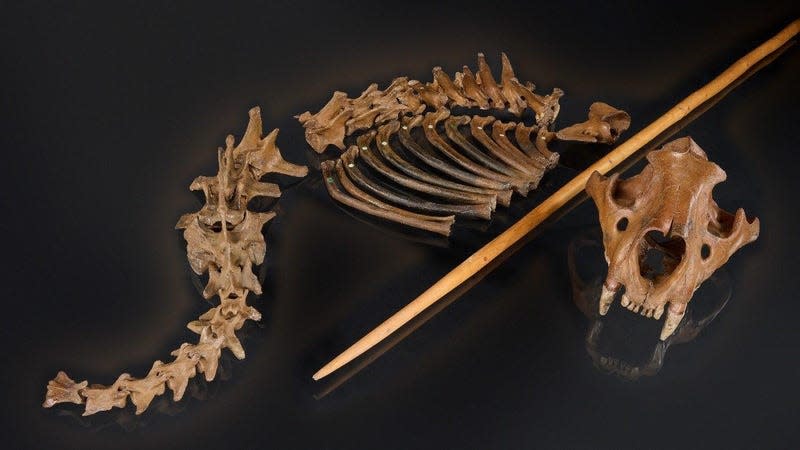Neanderthals Likely Killed and Butchered Cave Lions, Speared Skeleton Suggests

Marks on the ribcage of a 48,000-year-old cave lion skeleton suggest the animal was killed by Neanderthals, making it the first evidence that our nearest human cousins hunted the Ice Age predators.
A team of paleoanthropologists and archaeologists recently scrutinized the remains of four lions: the aforementioned skeleton, which was excavated in 1985 in Siegsdorf, Germany, and phalanges and sesamoid bones from three lion specimens excavated from Einhornhöle, Germany, in 2019. The former showed evidence of being punctured by a wooden-tipped spear—a known weapon of Neanderthals—and the latter three had cut marks that suggested they were butchered in a way to keep the animals’ claws preserved on the fur. The team’s research is published today in Scientific Reports.
Read more
Dragon Ball Daima Is The Newest DBZ Series And Toriyama Is Back
There's a new South Park "event" teaser and god, we're already so tired
Tommy Tuberville Falling Off A Plane Is The Best Thing We've Seen Since The Cop Slide
Only John Carpenter knows who’s the Thing at the end of The Thing
Woman Arrested After Wrapping Car To Look Like A Florida State Trooper
There’s no evidence of our own species, Homo sapiens—or any other hominin, for that matter—in the region at the time these lions died and were manipulated, Russo said, leaving Neanderthals as the sole party that could be responsible.
Evidence for human manipulation of lion remains goes back much further than 48,000 years. In 2010, a team of researchers published evidence of lion butchery and possible skinning in Spain a staggering 350,000 years ago. But explicit evidence that the predators were hunted has been harder to come by. The recent study also indicates that the lions’ claws were kept attached to the pelt, suggesting that the pelt had some ornamental value—it wasn’t just stripped off the creature to get at its meat.
“These interactions encompassed not only the cultural use of lion body parts but also the ability to hunt them,” Russo added. “Initially, this behavior was exclusively attributed to our species, Homo sapiens. However, Neanderthals were the first in the hominin lineage to gain the upper hand over predators, pioneering cultural relationships with them”
The phalanges interrogated in the recent paper are much more ancient than the nearly complete skeleton that indicated the lion was hunted; those paw bones date to at least 190,000 years ago, which the researchers state in the paper is the “earliest example of the use of cave lion skin by Neanderthals in Central Europe.”
Though no pelt was actually found, Neanderthals using lion skins for cultural purposes is hardly outside the realm of the expected. In 2021, a 51,000-year-old carved bone of a giant deer was attributed to Neanderthals, suggesting the human group made art with some animal remains. And the Neanderthals, who interbred so much with our own species that their DNA persists in most living people, were culturally nuanced; they took care of one another, hunted collaboratively, and made cave paintings.
Thus, the researchers concluded, the cave lion had some symbolic or aesthetic value to Neanderthals, as well as the obvious practical value that its meat and hide would provide.
More: How Do We Know What Neanderthals Looked Like?
More from Gizmodo
Michigan TV network fires sports director for Mel Tucker ‘analysis’ that read more like PR work
Sorry, What?! Florida Man Walks Free After Stabbing His Date, But It Gets Worse
Joel McHale has been streets ahead of Chevy Chase's insults since 2009
Sofia Coppola Sanitizes Elvis’ Cruelty Towards His Young Bride in ‘Priscilla’
Sign up for Gizmodo's Newsletter. For the latest news, Facebook, Twitter and Instagram.

